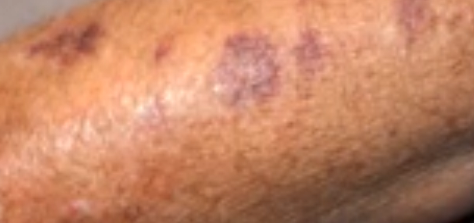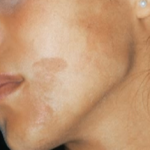The occurrence of purple spots on skin may indicate a harmless condition or the presence of varied severe underlying diseases. Some of the different causes of purple spots on skin are listed below.

Causes of purple spots on skin
- Bruises: One of the most common causes of purple spots are injuries which result in minor bruising. Bruises develop due to damage of the blood vessels present below the skin. The healing process of such bruises causes the affected skin area to change colors into maroon, red, brown, and purple.
- Cardiac and pulmonary conditions:There are some cardiac disorders like cyanotic heart disease, congestive heart failure, cardiomyopathy, and cardiogenic shock which cause purple spots on skin, or a purplish skin color. The skin may also become purplish or elicit purple spots due to varied lung diseases, including bronchiolitis, pneumonia, a serious asthma attack, choking caused due to presence of foreign matter in the airways, chronic obstructive pulmonary disease, epiglottitis, and croup. All the above listed conditions are severe and require urgent medical attention.
- Blood spots: A sudden onset of non-raised, reddish or purple spots on skin without any known injury may signify that such skin anomalies are blood spots. It is however important for patients to consult a doctor for proper diagnosis.Blood spots can be caused due to varied reasons like consumption of certain pain relievers, blood thinners, and other medications; hemophilia and other blood disorders; swelling or inflammation of the blood vessels; accumulation of toxic matter via infections; malnutrition caused due to deficits in some vital vitamins and minerals; cirrhosis, lupus, and similar blood clotting diseases; and cancers such as leukemia and multiple myeloma.
- Petechiae: It is a skin condition characterized by the formation of small, reddish or purple spots on skin or the oral lining. Such spots are caused due to rupture and subsequent bleeding from the small blood vessels occurring in the upper layer of skin or the topmost sections of a mucous membrane. The abnormal spots are not painful or itchy. They may be very tiny or the size of a pea. The petechial spots do not change color on application of pressure. Rapid spread of such spots may indicate deficient platelets or a serious infection, needing immediate medical care.
- Purpura:Sudden and serious bruising that is widespread or localized and caused without any external injury is known as purpura. It is usually caused due to clotting or bleeding disorders. Patients may also suffer from weakness, fever, malaise, and fatigue. The disease has a rapid onset over a few hours and may be an indication of a severe infection.
- Other causes: The skin may also turn purple or develop purple spots due to other causes such as breathing difficulties which results in lack of oxygen in the body, chemotherapy, contact with extremely cold temperatures, decreased platelet count, excessive intake of sedatives, travelling to very high altitudes, decreased blood supply to the skin, and a prolonged seizure, etc.
Treatment of purple spots on skin
Treatment of purple spots on skin is aimed at finding the underlying cause, managing the symptoms, and eliminating the cause via medications and other therapies.


